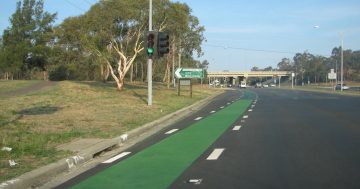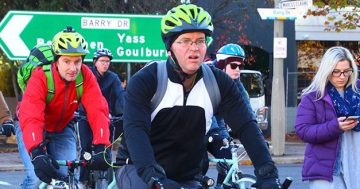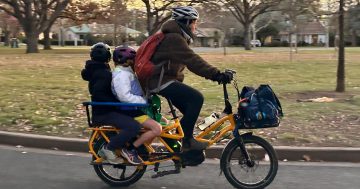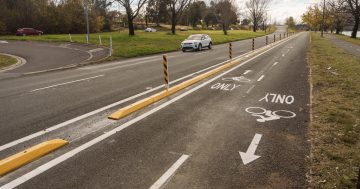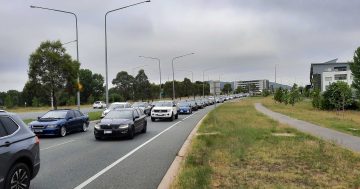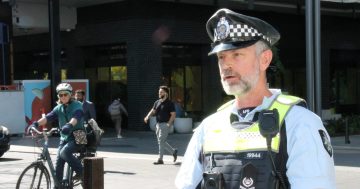Canberra has introduced new laws regarding bicycles on roads:
Cycling safety advocates have welcomed a planned trial of new minimum passing distances for drivers overtaking bike riders on ACT roads.
Attorney-General Simon Corbell announced the trial of mandated minimum distances, requiring drivers to leave one metre when passing in speed zones of up to 60 km/h and 1½ metres in speed zones faster than 60km/h.
So let’s just visualise this for a moment:
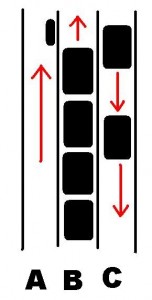
- So in lane A, heading north, we have a bicycle. As cyclists like to do in Australia, this cyclist is riding on the very edge of his lane, as close as possible to all the cars.
- In lane B, also travelling north, we have a line of cars.
- In lane C, travelling south, we have another lane of cars.
Now what usually happens if a car is travelling slowly in lane A is that the cars in lane B are free to pass by at a higher speed in lane B.
But with this new law,the cars in lane B would have to swerve right by one and a half metres, which would put them into head-on collision with the southward moving cars in lane C.
The average cyclist on a flat road travels at around fifteen kilometres per hour.
Therefore, with all car traffic prevented by law from passing the cyclist, all cars, trucks, and buses on the road must reduce their speed to fifteen kilometres per hour. The whole line of traffic is stuck going very slowly simply because one person chose to ride his bicycle in the left lane of that road. On a road with a normal speed limit of sixty kilometres per hour, that means it is going to take four times as long for all those people to get where they need to go.
One cyclist at work who felt a very strong emotional attachment to this issue opined that it’s the fault of the drivers for choosing to take that road, and that if they wanted to drive at sixty kilometres per hour on a road with a speed limit of sixty kilometres per hour, well, it’s their own fault for not choosing a road without cyclists on it. If they had any sense, he argued, they would have used their powers of prognostication and chosen some other road. This assumes that people should not normally be permitted to drive close to the speed limit.
Now, according to the laws of the Australian Capital Territory, a bicycle is most definitely a vehicle. It must be made clear that if a vehicle is obstructing traffic by driving well below the speed limit for a given road, that driver is committing an offence:
125 Unreasonably obstructing drivers or pedestrians
(1) A driver must not unreasonably obstruct the path of another driver or a pedestrian.
Offence provision.
Note Driver includes a person in control of a vehicle — see the definition of drive in the dictionary.
(2) For this rule, a driver does not unreasonably obstruct the path of another driver or a pedestrian only because:
(a) the driver is stopped in traffic; or
(b) the driver is driving more slowly than other vehicles (unless the driver is driving abnormally slowly in the circumstances).
Example of a driver driving abnormally slowly:
A driver driving at a speed of 20 kilometres per hour on a length of road to which a speed-limit of 80 kilometres per hour applies when there is no reason for the driver to drive at that speed on the length of road.
So that cyclist riding along at 15 kilometres per hour in a sixty kilometre per hour zone is actually breaking the law.
One might suggest “There is a reason: a bicycle is slow.” That very same argument could be used if someone drives a really crappy old car which barely moves. Someone is driving along at 15 kilometres per hour in a sixty zone because their car is a piece of junk. They are still in a vehicle, and still blocking the road for everyone else. The fact that the driver’s vehicle of choice is slow – indeed too slow to be on that road – is not the fault of all those other drivers.
So if we have cyclists insisting that bicycles are vehicles, and should be perceived as vehicles by all other vehicles and therefore deserve the rights of all other vehicles in traffic, should they not be held to the same laws as other vehicles?
But wait! Cyclists are also overjoyed at their new right to drive their vehicles over pedestrian crossings? But if they’re vehicles… that does not make sense. Could it be they want the benefits of having it both ways, yet want to avoid any responsibility to other motorists?
The aforementioned cyclist I know, when confronted with the logical problems with this situation, decided to abandon logic and simply demand “Why are you taking the drivers’ side anyway? You don’t even drive!” Well, that’s true. I’m not a car driver. What that means is that I have no particular bias in this matter, and am an impartial observer. If anything, one might expect me to sympthaise with cyclists, given that I used to ride a bicycle to work until I was hit by a car. But sympathy and emotional reflexes do not change the logic of the situation. Nor does declaring someone a partisan of one side or another change the facts and logic.
What we have here is a law which will ultimately mean one person choosing to ride a bicycle on a road has the right to block traffic and screw over everyone else who has chosen to use that road.












